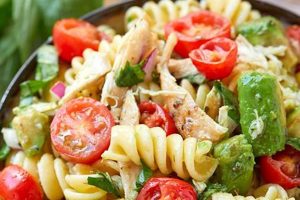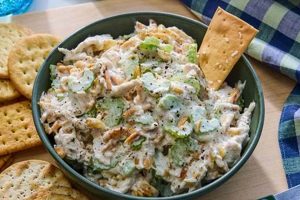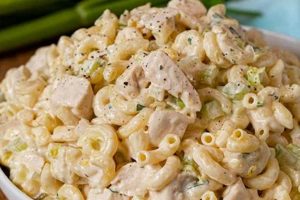Combining cooked chicken with mayonnaise forms the foundation of a classic dish, often enhanced with celery, onion, and seasonings. Adding grapes introduces a burst of sweetness and a pleasing textural contrast to the savory, creamy base. Recipes featuring this combination range from simple mixtures for everyday lunches to more elaborate preparations suitable for special occasions.
The incorporation of grapes elevates this traditional dish by adding a refreshing element and balancing the richness of the mayonnaise. This sweet-savory contrast offers a complex flavor profile that appeals to a wide range of palates. Historically, fruit and poultry have been paired in numerous cuisines, showcasing the enduring appeal of this flavor combination. The relative ease of preparation and the availability of ingredients further contribute to the enduring popularity of this dish.
This exploration will delve into variations on this classic combination, offering insights into ingredient selection, preparation techniques, and serving suggestions. Whether one seeks a quick and easy meal or a show-stopping centerpiece for a gathering, the following information will provide a valuable resource.
Tips for Enhancing Chicken Salad with Grapes
Several techniques can elevate chicken salad featuring grapes from simple to exceptional. Careful consideration of ingredients, preparation methods, and serving suggestions ensures a delightful culinary experience.
Tip 1: Grape Selection: Opt for seedless varieties such as red, green, or black grapes. Consider the sweetness level and texture of each variety, selecting one that complements the overall flavor profile.
Tip 2: Chicken Preparation: Utilize rotisserie chicken for convenience or poach boneless, skinless breasts for a leaner option. Ensure the chicken is cooled completely before combining with other ingredients.
Tip 3: Enhancing the Dressing: While mayonnaise serves as a traditional base, Greek yogurt offers a lighter alternative. Incorporating a touch of Dijon mustard or a splash of lemon juice adds depth of flavor.
Tip 4: Balancing Sweetness and Savory: Incorporating finely diced red onion or a sprinkle of celery seeds provides a savory counterpoint to the sweetness of the grapes.
Tip 5: Textural Variation: Toasted pecans or walnuts introduce a satisfying crunch, while chopped apples or pears offer a complementary textural element.
Tip 6: Serving Suggestions: Serve the salad on croissants, crackers, or lettuce cups. Garnish with fresh herbs, such as dill or chives, for visual appeal.
Tip 7: Chilling and Storage: Allow the salad to chill thoroughly in the refrigerator to enhance the flavors. Store leftovers in an airtight container for up to three days.
By employing these techniques, one can create a chicken salad with grapes that is both flavorful and visually appealing. Attention to detail elevates this simple dish, transforming it into a memorable culinary creation.
These tips provide a starting point for exploring the versatility of this classic combination. Experimentation with different ingredients and techniques allows for the creation of a personalized version suited to individual preferences.
1. Chicken (cooked, diced)
Cooked, diced chicken forms the foundational protein component of chicken salad incorporating grapes. The cooking method and dicing technique influence both the flavor and texture of the final dish. Poaching or baking chicken breasts yields a leaner result compared to using rotisserie chicken, which imparts a richer, more savory flavor. Dicing the chicken into uniform pieces ensures even distribution throughout the salad and consistent bite size. Overly large chunks can disrupt the balance of ingredients, while excessively small pieces may result in a dry or mushy texture.
Consider a scenario where shredded chicken replaces diced chicken. The resulting salad loses textural definition, becoming denser and less visually appealing. Conversely, using large, unevenly cut pieces diminishes the cohesiveness of the salad, making it difficult to serve and consume gracefully. Practical application of this understanding lies in selecting the appropriate cooking method and dicing technique to achieve the desired outcome. For a lighter salad, poached chicken breast diced into small, even pieces proves ideal. For a richer, more substantial salad, rotisserie chicken cut into slightly larger cubes offers a more robust flavor and texture.
The choice of chicken preparation and size directly impacts the overall success of the chicken salad. Balancing flavor, texture, and visual appeal hinges on thoughtful consideration of these elements. Understanding the importance of properly cooked and diced chicken ensures a harmonious blend of ingredients, transforming a simple combination into a delightful culinary experience.
2. Grapes (halved, seedless)
Grapes contribute a critical dimension of sweetness and texture to chicken salad, differentiating it from other similar dishes. The selection and preparation of grapes significantly influence the overall sensory experience. Seedless varieties, halved for optimal integration, offer the most convenient and enjoyable consumption. This section explores key facets of grape incorporation in chicken salad.
- Sweetness and Acidity
The balance of sweetness and acidity in grapes plays a crucial role in the flavor profile of the salad. Sweeter varieties, like red grapes, provide a pronounced contrast to the savory chicken and mayonnaise. Tart varieties, like green grapes, offer a brighter, more refreshing counterpoint. Balancing these flavors prevents the salad from becoming overly sweet or bland. Recipes often suggest a mix of grape varieties to achieve a complex flavor profile.
- Texture and Mouthfeel
Halving grapes ensures a pleasant texture and prevents whole grapes from dominating each bite. The firmness of the grapes also contributes to the overall mouthfeel. Overly ripe grapes can become mushy and detract from the textural experience, while underripe grapes may be too tart and firm. Choosing grapes with a slight firmness ensures a pleasing pop when bitten into.
- Visual Appeal
The color and appearance of the grapes contribute to the visual appeal of the salad. A mix of red and green grapes can create an attractive contrast, enhancing the presentation. The glistening surface of halved grapes adds a touch of freshness and visual interest to the finished dish. This visual element plays a crucial role in making the salad more appetizing.
- Practical Considerations
Seedless grapes offer convenience, eliminating the need for tedious seed removal. Halving the grapes not only improves texture but also ensures even distribution throughout the salad. This practical step prevents the grapes from clustering together and allows for a more balanced flavor in each bite.
The careful consideration of grape selection and preparation significantly impacts the overall quality and enjoyment of chicken salad. Balancing sweetness, acidity, texture, and visual appeal elevates this simple dish, transforming it into a more refined culinary experience. Choosing seedless grapes and halving them prior to incorporation ensures both convenience and optimal flavor integration within the salad.
3. Mayonnaise (or alternative)
Mayonnaise serves as the unifying element in chicken salad, binding ingredients and providing a creamy texture. Its properties influence flavor, consistency, and overall palatability. Alternatives offer variations in richness, tanginess, and dietary considerations, each affecting the final dish’s character. Understanding the role of mayonnaise and its alternatives proves crucial for achieving a successful balance of flavors and textures in chicken salad with grapes.
- Classic Mayonnaise
Traditional mayonnaise, an emulsion of oil, egg yolks, and vinegar or lemon juice, contributes a rich, creamy texture and tangy flavor that complements the savory chicken and sweet grapes. Full-fat mayonnaise offers the most authentic experience, while reduced-fat versions provide a lighter option with some compromise on richness. The emulsification process creates a stable mixture that coats the other ingredients, ensuring even distribution of flavor and moisture.
- Greek Yogurt
Greek yogurt offers a tangier, lower-fat alternative to mayonnaise. Its thicker consistency provides a creamy texture while reducing the overall richness of the salad. This substitution results in a lighter, brighter flavor profile that highlights the sweetness of the grapes. Greek yogurt also adds a subtle tang that balances the sweetness of the fruit and the savory notes of the chicken.
- Avocado
Mashed avocado presents a vegan and dairy-free option, contributing a creamy texture and subtle, buttery flavor. This alternative adds a healthy dose of monounsaturated fats, enhancing the nutritional value of the salad. The smooth consistency of avocado complements the grapes and chicken, creating a cohesive and satisfying dish. However, its distinct flavor may not appeal to all palates.
- Dairy-Free Mayonnaise
Vegan mayonnaise options, typically made with plant-based oils and emulsifiers, offer a similar texture and tang to traditional mayonnaise without animal products. These alternatives cater to dietary restrictions while maintaining the classic creamy consistency associated with chicken salad. However, flavor profiles can vary significantly between brands, requiring careful selection to achieve the desired taste.
The choice of mayonnaise or alternative significantly influences the overall flavor, texture, and dietary profile of chicken salad with grapes. Selecting the appropriate option requires consideration of the desired richness, tanginess, and health implications. Whether opting for the classic creaminess of mayonnaise or exploring lighter, plant-based alternatives, this ingredient plays a vital role in shaping the final culinary experience.
4. Seasoning (salt, pepper)
Seasoning, primarily salt and pepper, plays a crucial role in elevating chicken salad with grapes from bland to flavorful. Salt enhances the inherent flavors of the chicken and other ingredients, while pepper adds a subtle complexity and depth. The interplay of these seasonings creates a balanced flavor profile, preventing the sweetness of the grapes from overpowering the savory elements. Careful consideration of seasoning quantities prevents over-salting or an overly peppery taste, ensuring a harmonious blend of flavors.
Consider a scenario where salt is omitted. The chicken salad becomes flat and uninspiring, failing to showcase the distinct flavors of the individual ingredients. Conversely, excessive salt overwhelms the palate, masking the subtle nuances of the grapes and other components. The judicious use of pepper adds a layer of complexity, balancing the sweetness and enhancing the savory notes. Omitting pepper results in a less dynamic flavor profile, while too much pepper can create an unpleasant heat that detracts from the overall enjoyment.
Achieving the optimal balance of salt and pepper elevates the overall sensory experience of chicken salad with grapes. This seemingly simple step significantly impacts the final dish, transforming it from a basic combination of ingredients into a well-rounded and flavorful culinary creation. Understanding the importance of proper seasoning ensures a harmonious blend of sweet and savory elements, creating a truly satisfying dish. Further exploration of seasonings could include the addition of herbs, spices, or other flavor enhancers to complement the core ingredients and create unique variations on the classic recipe.
5. Texture (celery, nuts)
Textural contrast plays a vital role in the overall enjoyment of chicken salad incorporating grapes. Ingredients like celery and nuts introduce a desirable crunch, counterbalancing the softer textures of the chicken, grapes, and mayonnaise. This interplay of textures creates a more dynamic and satisfying sensory experience. Celery, with its crisp, watery bite, offers a refreshing contrast to the richness of the mayonnaise and the sweetness of the grapes. Nuts, whether toasted or raw, contribute a satisfying crunch and nutty flavor that complements the other ingredients. The absence of these textural elements results in a monotonous, one-dimensional mouthfeel.
Consider a chicken salad made solely with chicken, grapes, and mayonnaise. While the flavors may be balanced, the overall experience lacks the dynamic interplay of textures that elevates a dish from simple to exceptional. The addition of finely diced celery introduces a crisp, refreshing element that cuts through the richness of the mayonnaise. Toasted pecans or walnuts further enhance the textural profile, adding a satisfying crunch and a complementary nutty flavor. This combination of textures creates a more engaging and enjoyable culinary experience.
Understanding the importance of textural contrast in chicken salad with grapes allows for informed ingredient selection and preparation. The judicious incorporation of celery, nuts, or other texturally contrasting elements elevates this simple dish, transforming it into a more complex and satisfying culinary creation. This awareness empowers culinary exploration, allowing for the creation of personalized variations that cater to individual preferences and enhance the overall dining experience. Further exploration might involve considering alternative textural elements, such as chopped apple or water chestnuts, to create unique variations on this classic dish.
6. Serving (bread, lettuce)
The method of serving chicken salad with grapes significantly influences the overall dining experience. The choice of serving vessel, whether bread, lettuce cups, or other options, affects both presentation and perceived flavor. Considerations include the texture and flavor of the serving vessel, its ability to complement the salad’s ingredients, and its suitability for the intended occasion. This exploration delves into various serving methods and their impact on the enjoyment of chicken salad with grapes.
- Bread
Bread offers a classic and versatile vehicle for chicken salad. Options range from delicate croissants and crusty baguettes to hearty multigrain bread. The choice of bread influences the overall flavor and textural profile of the dish. A buttery croissant complements the richness of the mayonnaise, while a crusty baguette provides a textural counterpoint to the creamy salad. Practical considerations include the bread’s ability to hold the salad without becoming soggy and its suitability for the dining setting.
- Lettuce Cups
Lettuce cups provide a lighter, lower-carbohydrate alternative to bread. Crisp lettuce varieties, such as butter lettuce or romaine hearts, offer a refreshing contrast to the creamy salad and add a satisfying crunch. This serving method enhances the perceived freshness of the dish and caters to dietary preferences. However, lettuce cups may not be suitable for all occasions, particularly formal settings or situations requiring portability.
- Crackers and Crispbreads
Crackers and crispbreads offer a convenient and texturally diverse serving option. The variety of flavors and textures available allows for customization based on individual preferences. Seeded crackers add a nutty element, while plain crackers provide a neutral base that allows the flavors of the salad to shine. This method is particularly well-suited for casual gatherings or as a light snack.
- Presentation and Garnishes
The visual presentation of chicken salad with grapes enhances the dining experience. Garnishing with fresh herbs, such as dill or chives, adds a touch of elegance and complements the flavors of the salad. Arranging the salad on a platter with crackers or bread alongside creates an inviting display for buffet-style service. Thoughtful presentation elevates even the simplest chicken salad, transforming it into a visually appealing dish.
The serving method chosen for chicken salad with grapes significantly influences the overall perception and enjoyment of the dish. Careful selection of bread, lettuce cups, crackers, or other vessels, combined with thoughtful presentation, elevates this simple salad, transforming it into a more refined and satisfying culinary experience. Adapting the serving method to the specific occasion and dietary needs ensures a harmonious balance of flavors, textures, and visual appeal.
Frequently Asked Questions
This section addresses common inquiries regarding chicken salad recipes incorporating grapes, offering practical guidance and clarifying potential uncertainties.
Question 1: Can red and green grapes be used interchangeably in chicken salad recipes?
While both red and green grapes offer sweetness, they possess distinct flavor profiles. Red grapes tend to be sweeter, while green grapes offer a slightly tart counterpoint. Recipes may specify one type or suggest a combination for balanced sweetness and visual appeal. Substituting one for the other may subtly alter the flavor profile but remains generally acceptable.
Question 2: What is the best way to prevent grapes from bleeding into the chicken salad?
Adding the grapes shortly before serving minimizes bleeding. Thoroughly drying the grapes after halving also helps prevent excess moisture from seeping into the salad and diluting the flavors.
Question 3: How long can chicken salad with grapes be stored safely in the refrigerator?
Properly stored in an airtight container, chicken salad with grapes typically remains safe for consumption up to three days in the refrigerator. Beyond this timeframe, the risk of bacterial growth increases significantly.
Question 4: Can frozen grapes be used in chicken salad?
While frozen grapes can be incorporated, thawing them before adding them to the salad is recommended. Frozen grapes release excess moisture upon thawing, which can dilute the flavors and make the salad watery. Thawing and thoroughly drying the grapes before use mitigates this issue.
Question 5: What are suitable alternatives to mayonnaise in chicken salad with grapes for those with dietary restrictions?
Greek yogurt offers a lower-fat, tangier alternative to mayonnaise. Mashed avocado provides a vegan and dairy-free option. Several commercially available vegan mayonnaise products also offer suitable substitutes, although flavor profiles vary.
Question 6: Can other fruits be added to chicken salad with grapes?
Apples, pears, and dried cranberries often complement chicken salad with grapes, adding textural and flavor complexity. However, maintaining a balance of flavors is essential to prevent the salad from becoming overly sweet or fruity. Consider the sweetness and texture of additional fruits to ensure they harmonize with the existing ingredients.
Addressing these common inquiries aims to provide a comprehensive understanding of incorporating grapes into chicken salad recipes. Careful consideration of ingredients, preparation techniques, and storage practices ensures a safe and enjoyable culinary experience.
This FAQ section concludes the exploration of chicken salad with grapes. The subsequent section will provide a collection of curated recipes to inspire culinary experimentation and enjoyment.
Conclusion
Exploration of chicken salad recipes incorporating grapes reveals the interplay of sweet and savory elements, highlighting the importance of ingredient selection, preparation techniques, and serving considerations. From the foundational components of cooked chicken and halved grapes to the unifying role of mayonnaise and the textural contrast provided by celery and nuts, each element contributes to the overall sensory experience. Understanding the nuances of flavor balance, texture, and presentation elevates this seemingly simple dish into a versatile culinary creation.
The versatility of chicken salad with grapes allows for endless variations, encouraging culinary creativity and personalized adaptations. Whether adhering to classic preparations or venturing into innovative combinations, the fundamental principles of flavor balance and textural harmony remain paramount. Continued exploration of ingredient pairings and serving options promises further enhancement of this timeless dish, solidifying its place as a culinary staple.






